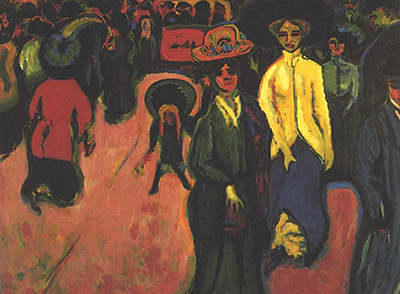The artist produced a series of city scenes of Berlin from 1913-1916 but this portrait of a Dresden street arrived later, coming in 1919. It is one of many Kirchner paintings to be found at the MoMA.
Dresden, a city in the South East of Germany, hosted Kirchner for an extended period after his time in Berlin and it was then that he produced this painting. The artist commented in written correspondence with some of his friends that he found this city to be an intriguing place with no shortage of unusual characters who were perfectly suited to his portrayals of city life. He found the place busy and felt forced to allow Dresden to swathe all over him, taking Kirchner in whatever direction it chose. This was unique to him, but also ideal for inspiring new paths of work, one example of which we find here.
There is a ghost-like expression in many of the faces in this painting, similar to some of the paintings of Norwegian artist Edvard Munch. It is believed that this was Kirchner's attempt at expressing some of the negatives, as he saw them, of city life. Business and loneliness were bed fellows in this unruly chaos, leaving individual residents with a lost look in their eyes, as if mesmerised by all around them. You can find similar in Munch's Anxiety, Melancholy and Evening on Karl Johan Street. This artist reached deep into the human mind in order to produce some extraordinary expressive artwork which is just as famous, perhaps more so, than the achievements of German Expressionists such as Kirchner.
This famous German was a member of the Die Brücke art movement and this group as a whole produced a large amount of work in the Königstrasse, a very exciting street in Dresden. Many of the members of this group felt that modern life was pushing society away from the authentic behaviour of previous times and that this should be addressed within their work. Industrialisation was a dirty word for artists right across Europe and inspired creative individuals far beyond just the German Expressionists such as Kirchner. One of the most obvious examples abroad would be the work in Britain of the likes of William Morris who despised the manufactured goods which were replacing traditional techniques, reducing quality and creativity in favour of lower prices.
Head to MoMA to see this artwork, though there is far more to do here than simply to focus on a single artist. The Sleeping Gypsy and The Dream by Henri Rousseau are two of the finest artworks to be found here, though the iconic Starry Night by Van Gogh must also be mentioned, naturally. Aside from those, look out for the likes of Pablo Picasso's Les Demoiselles d'Avignon and Two Children Are Threatened by a Nightingale by Max Ernst, which itself is one of a number of major surrealist pieces to be found here. All in all, this ranks as one of the most significant collections of contemporary art in the world, with most items dated between 1850 to the year 2000, with a particular focus on the first half of the 20th century which included some highly significant movements such as Surrealism and Cubism.




